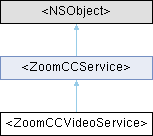Video service interface. More...
#include <ZoomCCInterface.h>
Inheritance diagram for <ZoomCCVideoService>:

Instance Methods | |
| (void) | - endVideo |
| Forcibly end to a video engagement. @discussion When this method is called, it closes the view created by the SDK, then returns to the application view. The service instances created inside ZoomCCSDK are released after this method is called. | |
| (BOOL) | - handleRejoinVideoOpenURL:item:videoDelegate:complete: |
| Handle to rejoin a video session that a user joined previously with the URL param from the "UIApplicationDelegate::application:openURL:options" method. | |
 Instance Methods inherited from <ZoomCCService> Instance Methods inherited from <ZoomCCService> | |
| (void) | - initializeWithItem: |
| Initializes the service. @Discussion After we get the service by method "[[ZoomCCInterface sharedInstance] chatService]" or method" [[ZoomCCInterface sharedInstance] videoService]", we should call method "initializeWithItem:" once to initialize the service. The method "initializeWithItem:" creates an internal instance to communicate with server. For the video calls, this method also initializes the ZoomVideoSDK. For chats, after this method been called, the service is prepared to start to communicate with server. We then call the method "login" to start the request to server at a flexible time when needed. | |
| (void) | - uninitialize |
| Used to uninitialize service @discussion After the method is called, the service's instance is released. Call this method when you do not need to use ZoomCCChatService or ZoomCCVideoService service. | |
| (BOOL) | - login |
| When calling method "initializeWithItem:", call this method to request to login to server. | |
| (BOOL) | - logout |
| When done using the service, call this method to disconnect from the server. | |
| (void) | - fetchUI: |
| Gets the UIViewcontroller instance of the service, which is then used to customize the display. | |
Properties | |
| ZoomCCVideoPreviewOption | videoPreviewOptions |
| Indicates if a video preview is available in the waiting room before a user enters the video session. See details in the definition of ZoomCCVideoPreviewOption. | |
| BOOL | autoJoinWhenVideoCreated |
| Indicates if when agent accept the video request, a user will auto-join the video session. When this property is set to YES, a user will auto-join the video session. When set to No, a user won't auto-join the video session. | |
| id< ZoomCCServiceDelegate > | videoDelegate |
| The video channel delegate. | |
 Properties inherited from <ZoomCCService> Properties inherited from <ZoomCCService> | |
| ZoomCCItem * | item |
| Retrieves information about the service. | |
| ZoomCCSDKStatus | status |
| Retrieves the current service status. | |
| BOOL | inEngagement |
| Retrieves the service's current engagement status. | |
| NSString * | engagementId |
| Retrieves the service's engagement ID. | |
Detailed Description
Video service interface.
Method Documentation
◆ handleRejoinVideoOpenURL:item:videoDelegate:complete:
| - (BOOL) handleRejoinVideoOpenURL: | (NSURL *) | rejoinURL | |
| item: | (ZoomCCItem *) | item | |
| videoDelegate: | (id< ZoomCCServiceDelegate >) | videoDelegate | |
| complete: | (void(^)(UIViewController *_Nonnull viewController)) | complete |
Handle to rejoin a video session that a user joined previously with the URL param from the "UIApplicationDelegate::application:openURL:options" method.
@discussion When a user is in a video session, pop up an alert for the user. When a user chooses to leave and rejoin, the current video session is ended and the user will join a new video session created from "rejoinURL", and the complete block will be called. When a user selects the alert's cancel option, the user stays in the current video session.
When user isn't in a video session, we will create a video session from the "rejoinURL" internally and the complete block will be called.
- Parameters
-
rejoinURL The URL that contains info to initialize a video session customer entered before. item The item with entryId and channel(video). videoDelegate Video delegate to receive callbacks. complete When a video session is initialized, the compete block will be called and the param viewController is the video entry page that developers should push from their view.
The documentation for this protocol was generated from the following file: